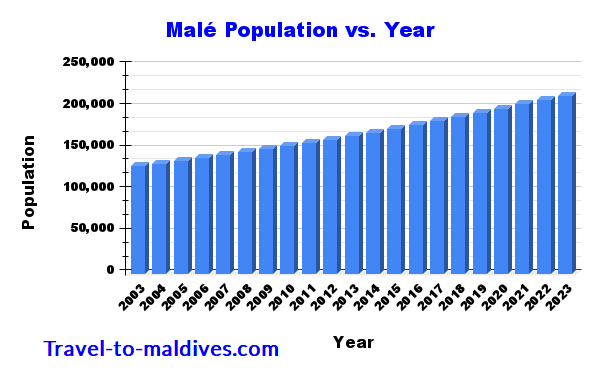Diversity in Malé
The population of Maldives is predominantly Maldivian, with a diverse mix of ethnic and cultural groups. The Maldivian population is believed to be descended from various Indo-Aryan and Dravidian groups from the Indian subcontinent.
Malé’s population is a melting pot of cultures, ethnicities, and backgrounds. As the economic and political hub of the Maldives, the city attracts people from all over the country and beyond.
This diversity is reflected in the various languages spoken, with Dhivehi being the official language. Still, English and other languages are also widely understood.
You’ll find Maldivians of different ethnic backgrounds living in Malé, including the indigenous Maldivian population and people from South Asia, particularly India, Bangladesh, and Sri Lanka.
This mix of cultures contributes to the city’s vibrant atmosphere. It offers a unique opportunity to experience a variety of cuisines and traditions.
Density in Malé
Malé is one of the most densely populated cities in the world, with a population of 252,768 and an area of 8.30 square kilometers, making it one of the most densely populated cities in the world.
This high population density has led to unique urban challenges. The cityscape is characterized by tall, narrow buildings and efficient use of limited space.
The streets are often bustling with activity, and public transportation is crucial to daily life. Despite the congestion, Malé maintains an intriguing charm that attracts visitors worldwide.
Chart Of Malé Population Growth

Growth Trends in Malé
Over the past few decades, Malé’s population has experienced significant growth. This trend can be attributed to various factors, including rural-to-urban migration, economic opportunities, and a desire for better education and healthcare facilities.
As the Maldives continues to develop and modernize, Malé remains a magnet for people seeking a better life. The city has expanded vertically and horizontally, with land reclamation projects increasing its physical size. However, the limited land area poses challenges for accommodating this growing population sustainably.
The government has initiated various development projects to address these challenges, including infrastructure improvements, housing initiatives, and environmental conservation efforts. These endeavors aim to ensure that Malé remains an attractive and livable city for residents and tourists.
Malé’s population is a testament to the city’s dynamic and cosmopolitan nature. Its diversity, high population density, and growth trends make it a unique and captivating place to explore.
While the challenges of managing a rapidly growing population in a limited space are evident, the resilience and creativity of the people of Malé continue to shape this remarkable city.
FAQ
What percentage of Maldives live in Male?
According to the Maldives Bureau of Statistics, 47% of the Maldives’ population lives in Male’. This means that about 249,779 people live in Male’ in 2023.
What is the Malé population in the Maldives 2023?
The population of Malé ‘ in 2023 is estimated to be 249,779 people. This number is based on the latest Maldives Bureau of Statistics estimates.
Is the Maldives heavily populated?
Yes, the Maldives is considered to be a heavily populated country. The population density of the Maldives is 1,229 people per square kilometer. This is much higher than the global average of 55 people per square kilometer.
Why is Malé so densely populated?
There are a few reasons why Male’ is so densely populated. First, Male’ is the Maldives’s capital and home to the government, businesses, and major tourist attractions.
Second, Male’ is the only island in the Maldives with an international airport. This makes it the gateway to the country for both tourists and immigrants. Third, Male’ is a very small island, with an area of only 2 square kilometers. This means that the population is concentrated in a very small area.
The high population density in Male’ has several challenges, including traffic congestion, pollution, and a need for more affordable housing. The government is working to address these challenges, but it is difficult.